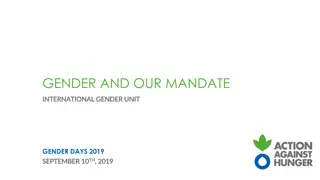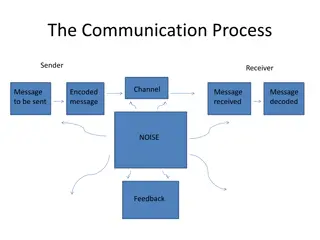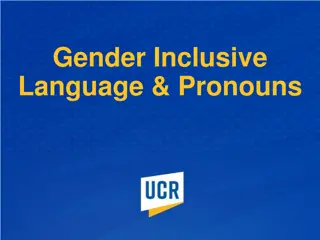Understanding Gender Diversity and Communication Etiquette
Explore various terms related to gender diversity, including cisgender, transgender, non-binary, and intersex. Learn about respectful communication practices such as asking preferred pronouns and using trigger warnings. Enhance your understanding of different gender identities and expressions in a supportive manner.
Download Presentation

Please find below an Image/Link to download the presentation.
The content on the website is provided AS IS for your information and personal use only. It may not be sold, licensed, or shared on other websites without obtaining consent from the author. Download presentation by click this link. If you encounter any issues during the download, it is possible that the publisher has removed the file from their server.
E N D
Presentation Transcript
The Basics (kind of)
Words, Words, Words O Aliagender Demigirl Neutrois O Aro-spectrum Misterie O Intergender Ace
O Transgender: An umbrella term encompassing a wide variety of people who feel that the gender assigned to them at birth is inaccurate or incomplete. O Transition: The process of changing one s gender identity and/or physical embodiment, which may or may not include medical intervention, wardrobe choices, or a name change. For some the process has a distinct end point, for others it is an ongoing process of self-discovery and transformation. O Cisgender/Cissexual: Someone who feels that the gender assigned to them at birth is relatively accurate and complete. The Greek prefix cis literally means on the same side of, or not trans. O Male-assigned: When a person s body is designated male at birth. Is used instead of (and is preferable to) the more common biologically male or male-born. O Female-assigned: When a person s body is designated female at birth. Is used instead of (and is preferable to) the more common biologically female or female-born.
O Non-binary gender: An umbrella term encompassing a wide variety of people who do not feel comfortable identifying entirely or exclusively as male or female, but rather prefer a fluid identity, a combination of both, no gender at all, or something else entirely. Many use the word genderqueer, and there are a wide variety of non-binary pronouns including they/them/their and ze/hir. Non- binary people may also choose to transition physically in various ways. O Gender non-conforming (GNC): A shorthand used for people who may or may not identify as trans, but who s behaviors are typically considered cross-gender. While no one is completely gender- conforming, people generally referred to as GNC tend to be consistent and comfortable with cross-gender expression, and are uncomfortable conforming to their typical gender roles. A term recently in vogue is gender-independent. O Intersex: An umbrella term for a variety of medical conditions that may result in genitalia that aren t easily classified, or a hormonal or genetic makeup typically seen in the opposite assigned sex. Formerly referred to as hermaphrodites, that term is considered both inaccurate and offensive. Some intersex people identify as trans, and some trans people (arguably erroneously) identify as intersex.
What If I Dont Know What To Say? O Listen O Echo
Things To Ask O It s sometimes okay to ask a person what pronoun they use, but not always. Only ask if you need to know, and it s not that hard to avoid pronouns ( this person, etc.) O Ask before referring a request to a colleague. O Trigger warnings/content notes, or gauge sensitivity sensitively.
Things To Never Ask O What are you Are you a boy or a girl Are you trans etc. O If a patron asks for the restroom, you can direct them to both.
Just Part of the Job O Adults and teenagers already don t understand each other. O You don t need to understand someone fully to provide them with services. O Unique needs of LGBTQ youth are still important to examine. O Sensitive service is built into the profession
Privacy Specific concerns for/of LGBTQ youth
Basic Privacies O What is included in a patron s right to privacy? O Why might these be of particular importance to LGBTQ youth?
According to a 2009 survey of 7,000 LGB youth: O 8 out of 10 reported verbal harassment O 4 out of 10 reported physical harassment O 6 out of 10 felt unsafe at school O 1 out of 5 had been physically assaulted O All statistics retrieved via http://www.cdc.gov/lgbthealth/youth.htm
LGBT Homeless Youth Provider Survey conducted from 2011-2012, found: O 30% of youth in housing programs or receiving street outreach identify as LGBT O 43% of youth in drop-in centers identify as LGBT O 46% ran away from home due to homophobia O 43% were forced out of their homes due to homophobia O 32% reported abuse O Full survey available at http://williamsinstitute.law.ucla.edu/wp- content/uploads/Durso-Gates-LGBT-Homeless-Youth- Survey-July-2012.pdf
Do You Advertise Privacy? O Bulletin board displays O Signs at reference and circulation desks O Teen Advisory Groups O Patron interactions O Outreach to schools
Privacy, one-on-one O Do you mind if I ask another librarian? O Volume of conversation O Awareness of people who are nearby, including parents O Modulate based on the patrons affect, of course.
Readers Advisory & Reference Being helpful while also being sensitive!
This is why we became librarians! O For LGBTQ teens still figuring things out, approaching the reference desk for help finding a resource might be a huge step, so let s honor that! O As librarians, we appreciate the need for uncensored access to information, and creating a safe environment for patrons to ask for help searching is part of that
Respect privacy O Disrespecting privacy during LGBTQ teen reference/RA interactions risks: O Losing that patron (in the least) O Outing that patron and subjecting them to violence, housing issues, bullying, etc. O Do your best to read the user s comfort level--if they are whispering, you may want to: O Use vague language (i.e. that subject ) O Lead them to the section in the stacks where the books will be found so that you can pull/show books O Write book titles down O Speak softly O Obviously if a reader seems more comfortable with the subject, you can be a little more open, but always exercise discretion regardless
Show LGBTQ users that you are friendly but not too friendly! O Identifying yourself as an LGBTQ-friendly adult may help kids feel safe coming to you O If a user asks you an LGBTQ-related reference of RA question, do your best to send them home with something useful O Know your collection this is the best way to prepare for an LGBTQ-related RA or reference question especially if you don t have the book they ask for but have other O Don t go overboard though it is one thing to express that you are knowledgeable about the subject area, and quite another to make a user feel singled out or in the spotlight.
Know the collection O Be familiar with the range of LGBTQ teen- appropriate titles in your collection. O Be prepared to recommend both fiction and non- fiction, as well as materials in the adult collection. O Internet resources these are so important to LGBTQ teens, as there is a lot more available on the Internet than in print O Be aware that there are some instances in which a combination of fiction, non-fiction, and electronic resources might be appropriate for the same RA/reference question O Trigger warnings as part of sensitive RA
Collection Development Locating, Evaluating, and Integrating LGBTQ-related materials
Locating materials O Professional sources Such as SLJ, Kirkus, Novelist, professional events, GLBT Roundtable of ALA (Rainbow Booklist, etc.) O Crowd sources O Cross-reference professional resources with user-driven resources eg GoodReads, Tumblr, blogs.
How do you evaluate titles? O What are your criteria? O Literary merit? O Treatment of trans protagonists or characters? O Authority? O Evaluate not for censoring purposes, but it s important for providing helpful readers advisory. O Who else likes this book?
Challenged materials O Do you have a challenged materials form? O Do you know your library s stance on LGBT materials, and how a challenge would be handled? O Resources include ALA s Office of Intellectual Freedom, National Coalition Against Censorship, and the PEN Foundation
Organizing your Collection
Make books easy to find! O While you should always be available for LGBTQ- friendly reference/RA, privacy concerns make it important that materials are easy for teens to find on their own O Two different ideas for making books to find are: O Creating an LGBTQ neighborhood in your teen collection O Using DemCo stickers to label the back of the spine of LGBTQ books within the collection O There are benefits and drawbacks to both of these approaches
Promoting your collection O Create LGBTQ themed book displays definitely in June for Pride month, but try making them for other events such as Trans Day of Remembrance, National Coming Out Day, World AIDS Day, etc. O Create outreach materials such as bookmarks to promote LGBTQ collections O You might go around and slip the bookmark into the pages of LGBTQ books on the shelves so readers who find one book can find the whole collection
Privacy O As with other topics, privacy is always an issue with making your collection more visible. O You may want to survey teens about their preference for displaying your collection. O If you use DemCo stickers, you may want to have copies of the same book without the DemCo sticker or to use a sticker that doesn t scream gay once the book leaves the library
Internet is sometimes the BEST resource O Social networking as community O Constantly changing information
Internet Safety O Parent concerns O Teen safety O Meeting friends from the Internet
List of Internet Resources Scarleteen comprehensive, non-judgmental, harm-reduction based sex ed resource http://www.scarleteen.com/ O Tumblr: Tumblr is an excellent platform for LGBTQ teens to build an online social network while exploring identities and ideas. Users share/reblog each other s content, which makes it a great site for users who want to build community while remaining anonymous O TrevorSpace: A monitored social networking site for LGBTQ teens https://www.trevorspace.org/ O Suicide, mental health, homelessness resources: O The Trevor Project http://www.thetrevorproject.org/ O It Gets Better Project: http://www.itgetsbetter.org/ O National Runaway Safeline http://www.1800runaway.org/ O Resources for LGBTQ students O GLSEN http://www.glsen.org/ O GSA Network http://www.gsanetwork.org/ O PFLAG: Parents, Friends & Family of Lesbians and Gays http://www.pflag.org/ O
Programming: LGBT-specific programming
What is general programming? O What kinds of programs to you host? O Are there programs geared towards specific audiences? O How do you state that without being exclusionary? Or are you exclusionary?
Making programs safer spaces for LGBT youth O Guidelines, including confidentiality, respect, protocol for accountability, optional pronoun preferences O Outreach to gay-straight alliances, college resources centers, support groups, shelters and housing programs
Some programming ideas O If there aren t GSAs at local high schools, the library could host one O Bring in presenters to educate around safer sex, bullying, mental health, etc. O Parties, dances, celebrations O Books clubs, including mock Stonewall Prize club O Author events
Timely displays and program opportunities O June is Pride Month O October is Queer Awareness Month, including National Coming Out Day O National Day of Silence in April O December 1st is World AIDS Day O Or highlight LGBT contributions to the civil rights movement (eg Bayard Rustin) women s history, literally anything else.
All pictures courtesy of Ingrid Van Opel at magpielibrarian.wordpress.com, via Tumblr
Programming: General programming: LGBTQ-friendly programing geared toward a general audience
Incorporating LGBTQ themes into general teen programing O Although LGBTQ-specific programming is important, many LGBTQ teen programming needs overlap with those of a more general teen audience O If you are having trouble building a large enough audience for LGBTQ-specific programming, creating programming that address LGBTQ needs but are geared toward a general audience is a way of still creating those programs O You may try incorporating multiple outreach strategies for one program to market to different audiences.
LGBTQ-Friendly General Programming Ideas O Internet and social Internet and social- -networking workshops networking workshops O Social networking workshops to focus on both fun + safety O Emphasizing Internet safety may make parents of LGBTQ teens more comfortable letting their kids explore the Internet O Book clubs Book clubs O Select LGBTQ-themed books for discussion in your book clubs O Authors & performers Authors & performers O Bring in LGBTQ presenters O Even if the presenter is talking about something non-LGBTQ related, many teens will feel inspired by just connecting with a talented or successful LGBTQ adult
LGBTQ-Friendly General Programming Ideas (cont.) O Anime clubs Anime clubs O A lot of anime & manga is advanced in LGBTQ inclusion, and your library may already have an anime club O Take extra measures to make your anime club an explicitly LGBTQ-friendly space O When selecting meeting themes, periodically choose LGBTQ-related themes O Diversity Diversity O Have broader diversity-related trainings and workshops O Create a library culture in which talking about diversity/oppression is part of all programs























